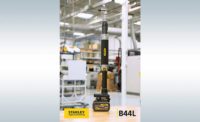What’s New With Blind Riveting

The Robo-Rivet automatically drills a hole and installs a structural blind fastener in approximately five seconds. Photo courtesy ARM Automation Inc.

Once the hole has been drilled, the robot indexes the Robo-Rivet so the rivet can be installed. The tool, not the robot, advances the riveter to the workpiece. Photo courtesy ARM Automation Inc.

Fasteks speed rivets are preloaded on the riveting mandrel. The fasteners can be installed at a rate of 70 per minute. Photo courtesy Bossard NA

BZ riveting tools are made from cast aluminum and wrapped in high-strength resin for durability in tough environments. Photo courtesy S-B Industries


The increasing use of aluminum in cars, trucks and other products is generating renewed interest in structural blind fasteners. Photo courtesy Alcoa Fastening


Bulb-Tite rivets form three legs that evenly distribute the load over the workpiece, making them ideal for soft, thin and even brittle materials. Photo courtesy Gesipa USA








As automakers increase their use of aluminum, composites and other lightweight materials, they are finding that tried-and-true joining methods, such as spot welding, are becoming less useful.
“For years, engineers designed-out fasteners in favor of welding,” says Troy Pierce, senior design engineer at Alcoa Fastening Systems and Rings. “Now that they need to join dissimilar metals, there’s been a big push to design fasteners—and especially structural blind fasteners—back into their products.”
It’s not just automakers that are wrestling with the problem, either. Manufacturers of heavy trucks, white goods, tractors and other large assemblies are also looking for ways to join dissimilar materials. For example, John Deere recently introduced a sprayer boom made from aluminum and high-strength steel. It’s assembled with structural blind fasteners from Alcoa.
“We haven’t released a lot of new fasteners lately, but we’re getting into a lot of new markets,” says Pierce. “We’re getting into more automotive applications. We’re getting into solar panel manufacturing and infrastructure applications, such as [cell phone towers]. It’s been an exciting couple of years.”
While newer technologies, such as flow drilling screws and even structural adhesives, have been getting attention for mixed-material assemblies, engineers are beginning to reacquaint themselves with blind rivets. Indeed, some manufacturers are using structural blind fasteners to complement structural adhesives in many applications. The rivets provide structural strength and also fixture the parts while the adhesive cures.
“When people think of rivets, they think of the cheap, nonstructural rivets they buy at the hardware store,” he says. “But there’s a big difference between a nonstructural rivet and a high-strength structural rivet.”
For example, Alcoa’s Huck BOM structural blind rivet offers very high shear strength, tensile strength and vibration resistance. A 0.1875-inch fastener has a shear strength of 2,800 pounds and a tensile strength of 1,800 pounds. It is available with grip ranges as small as 0.093 to 0.156 inch or as large as 0.72 to 0.781 inch. A 0.75-inch fastener produces a shear strength of 45,100 pounds and a tensile strength of 29,100 pounds. It comes in grip ranges as small as 0.251 to 0.5 inch or as large as 1.001 to 1.25 inches.
The BOM rivet is installed like any other blind fastener, but with an extra swaging action on the front side of the fastener. The fastener is inserted into the hole and the installation tool is slipped over the pintail. When the trigger is pressed, the tool pulls on the pintail. The fastener has a unique collar design that “stands off” the swaging action until the maximum allowable bulb is formed on the back side.
Continued pulling on the pintail draws the workpieces together, and a swaging anvil overcomes the standoff and moves down the length of the collar, securely locking the collar to the pin. Once the collar is swaged, the pin breaks, leaving a high-strength, vibration-resistant joint.
Robotic Riveting
Increased demand for structural blind rivets has, in turn, spurred innovation in the tools for installing them. Semiautomatic equipment for installing blind rivets—handheld tools with automatic rivet feeding—has long been available. However, fully automatic systems have been harder to come by.
Now, systems integrator ARM Automation Inc. has introduced the Robo-Rivet, a fully automatic machine that combines drilling and riveting tools into a single, compact assembly that can be mounted to a stanchion, a gantry or a six-axis robot.
About the size of a breadbox, the Robo-Rivet automatically installs structural blind rivets in such applications as automotive, truck, trailer and railcar assembly.
“We’re aimed at high-volume applications that need more than the typical commodity hand tool,” says Derek Black, vice president of business development at ARM Automation. “In high-volume applications, hand tools just aren’t up to snuff in terms of reliability and duty cycle. Some manufacturers are placing millions of rivets, so our equipment is designed to be robust, safe and reliable.”
The system can accommodate rivets up to 0.3125 inch in diameter. Virtually any type of structural blind fastener can be installed with the system: long or short; wide or thin; truss heads or countersunk heads.
“We can feed multiple fastener types to the same head, as long as they have comparable pintails,” says Black. “So if an assembly calls for three different fasteners, we can set up three feeders in our supply stand and feed them in sequence to the gun.”
Or, one feeder can supply up to four rivet tools with the same fastener.
The system works like this: The robot positions the Robo-Rivet over the fastening location. (About 1 inch of clearance is needed around each hole location.) Then, a spindle extends to drill a hole in the parts. The spindle can turn at up to 24,000 rpm. Chip collection and drill cooling are optional.
“We don’t use the robot motion to do the drilling,” Black points out. “The robot positions the tool, and the tool extends the drill. It’s a pure linear motion. Six-axis robots are good, but they’re not great at linear motion.”
Once the hole has been drilled, the robot indexes the tool so the rivet can be installed. Here, too, the Robo-Rivet, not the robot, advances the riveter to the workpiece. The riveter then inserts a rivet into the hole and sets it.
The entire process takes five seconds. “We can get down to four seconds, if pushed, but it depends on the application,” says Black.
During drilling, the system measures the torque of the spindle and verifies chip collection. During riveting, the system measures the contact force on the parts and the pull force needed to set the rivet. It also verifies that the spent mandrel has been collected. Both the drill and the rivet axes are servo-controlled and provide force feedback and fault detection.
In addition, a vision system at the supply stand inspects each rivet as it exits the feeder.
Black sees his technology as competition for robotic spot welding and robotic installation of self-piercing rivets or flow drilling screws. Robo-Rivet is already being used by an automotive OEM and a manufacturer of heavy trucks.
“We’re not inventing a new process here,” he says. “We’re automating a process that’s been around for a long time. Blind fasteners have received short-shrift over the past few years, but there are many applications today where they make a lot of sense. They offer good clamp-up, good shear performance, and they are structural fasteners.”
To see a video of the Robo-Rivet in action, click http://tinyurl.com/p2x7jjp.
New Tools
While technologies like the Robo-Rivet have certainly captured the spotlight, handheld power tools have not been neglected.
In April, S-B Industries Inc. introduced the BZ103A and BZ123A pneumatic riveting tools to the North American market. Designed and manufactured in Germany by VVG Fasteners, the riveters are made from cast aluminum and wrapped in high-strength resin for durability in tough environments. Four nosepieces are conveniently stored in the base of the tool.
The BZ103A weighs 3.9 pounds and has a stroke of 18 millimeters. It accepts mandrels up to 3.4 millimeters in diameter. Producing a pull force of 11,700 newtons, it can set aluminum rivets from 2.4 to 5 millimeters in diameter, and steel, stainless steel and copper rivets from 3 to 5 millimeters in diameter.
The BZ123A weighs 5.1 pounds and has a 25-millimeter stroke. It accepts mandrels up to 4.8 millimeters in diameter. It produces a pull force of 18,700 newtons and can set aluminum and steel rivets from 4 to 8 millimeters in diameter. It sets stainless steel rivets from 4 to 6.4 millimeters in diameter and copper rivets from 4 to 6 millimeters in diameter.
The riveters have a high-capacity mandrel collector fed by an “energy-friendly” vacuum system. The operator can regulate the air used to eject the spent mandrel by turning a knob at the base of the tool. The vacuum can be on all the time; it can run intermittently (1- to 5-second intervals per set); or it can turn off when the tool is idle.
“Many riveting tools use a vacuum collection system for the mandrel, but there’s a cost associated with that,” says Michael Mervis, vice president of sales and marketing for S-B Industries. “This feature reduces the operating cost of the tool.”
Following a trend with screwdrivers and nutrunners, a number of riveters are now available in cordless models. S-B Industries, Gesipa USA, Alcoa and Vega Tool Corp. all offer cordless tools.
“Cordless riveting tools have been around for a long time, but frankly, until now, the technology had not reached the same level of dependability as cordless screwdrivers and nutrunners,” says Mervis. “We’re there now. In fact, we have a number of customers that have done away with their compressed air systems and taken pneumatic tools out of their plants.”
The VT400 Rivdom cordless riveter from S-B Industries is powered by a 14.4-volt lithium-ion battery that will recharge in less than one hour. With 2,023 pounds of traction and a 21-millimeter stroke, the tool sets aluminum, steel, stainless steel and copper blind rivets up to 4.7 millimeters in diameter. Without the battery, the tool weighs 3.39 pounds. It accepts mandrels up to 3.4 millimeters in diameter.
“We will offer a cordless rivet-nut setter by the end of the year,” adds Mervis.
The next big trend in riveting tools, experts say, will be error-proofing and data collection. Assemblers want tools that can count spent mandrels and measure clamping pressure and pull force. While such technology has been out for a while, it has yet to be widely adopted.
“There’s a big push from the automotive industry for data reporting,” says Mervis. “But, as with cordless technology, riveting tools have been late to the game in terms of data collection.”
Looking for a reprint of this article?
From high-res PDFs to custom plaques, order your copy today!














